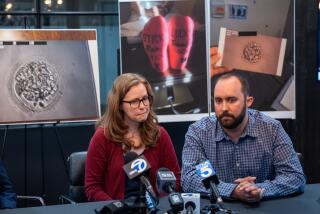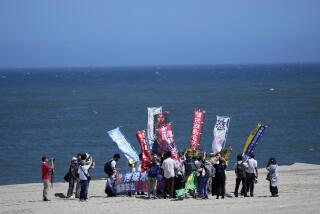Shortcomings Surface at Nuclear Site
- Share via
TOKYO — The uranium processing plant where Japan’s worst nuclear accident occurred was using an illegal operations manual that directed workers to save time by mixing a uranium solution in stainless steel buckets, and workers had been performing that procedure--cited as one of the causes of Thursday’s nuclear fission reaction--for four or five years, company officials admitted Saturday.
The revelations reverberated throughout Japan today.
“This is completely unforgivable. I have nothing else to say,” said Masaru Hashimoto, governor of Ibaraki prefecture, where the accident in the town of Tokaimura irradiated 49 people. “This is outrageous, or rather it’s insulting.”
“Unbelievable!” declared a Sunday morning television talk show.
Hiroyuki Ogawa, head of manufacturing for the plant, held a news conference Saturday at which he disclosed the existence of the manual, which had been revised in 1997 and had never been submitted for the required government approval. Ogawa said company officials were well aware that the illicit procedure, in which uranium oxide was dissolved in a solution in stainless steel buckets, produced toxic emissions.
“This is a safety problem,” Ogawa said. “We knew if we asked for formal approval, we would not get it.”
The Science and Technology Agency called the manual “illegal.” Authorities said they would search the JCO Co. plant today for evidence of violations of nuclear safety laws.
The manual reportedly ordered workers to “prepare three clean stainless steel buckets,” and Ogawa said he had witnessed workers using such buckets to mix the uranium solution for four or five years. The procedure bypassed the factory’s elaborate system of preparing the uranium slowly, using a system of three different tanks connected by pipes with metering devices attached to ensure that dangerous concentrations of uranium could not occur.
Ogawa said the bucket method was used as a timesaver because it took just 30 minutes compared with the three hours needed to pipe the chemicals through the vats in the proper procedure.
One of the workers seriously injured in the accident, Yutaka Yokokawa, 54, told police in an interview from his hospital bed Friday that the bucket procedure was used frequently, according to Japanese news reports.
Hospital officials disclosed for the first time Saturday that two other workers, Hisashi Ouchi and Masato Shinohara, had received more than lethal doses of radiation. Ouchi received 17 sieverts of radiation, Shinohara received 10 sieverts, and Yokokawa was exposed to 3 sieverts. Seven sieverts is considered a lethal dose, and the exposure standard for ordinary Japanese citizens is 0.001 sievert at a time, according to Japanese news reports.
One sievert is equivalent to 100 rem. It is a measurement of potential radiation damage to living organisms.
Ouchi, 35, was transferred to Tokyo University Hospital on Saturday to receive a blood transfusion taken from a newborn’s umbilical cord, in a procedure that doctors hoped would compensate for his deteriorating ability to produce blood. Shinohara, 39, was also listed in critical condition.
The Tokaimura accident is being considered the third worst in history, after the Chernobyl and Three Mile Island nuclear disasters. However, on Saturday, Japanese officials permitted the last evacuees within a quarter-mile radius of the uranium processing plant to return to their homes and declared that the area around the plant is safe and that local crops, livestock and fish pose no health hazards.
Other troubling details of how the accident could have occurred continued to emerge this weekend, as a host of other design and safety procedural violations were disclosed that altered the initial perception that irresponsible workers alone were to blame.
Among other factors, the workers Thursday were handling an unusually high-grade and potentially dangerous kind of uranium without special training or safety procedures. They also allegedly violated even the company’s secret, timesaving procedures by dumping three buckets of the uranium solution into a sedimentation tank, triggering the reaction. Four buckets of uranium had already been added to the tank the night before.
Moreover, once the accident occurred, officials did not immediately report the radiation leakage, so that three firefighters who were sent to the plant arrived without protective gear and were also contaminated, the Asahi newspaper reported. It was not known how much radiation they received.
JCO officials were slow to respond to the nuclear fission reaction once it began, in part because all three of the factory’s alarm bells began to ring simultaneously, making it impossible to immediately determine in what part of the plant the accident had occurred, the Asahi said. The plant reported the accident by fax to Tokaimura officials at 11:54 a.m., 61 minutes after the accident occurred, instead of telephoning authorities.
Even as the nuclear reaction was taking place, officials reportedly spent the extra time preparing a document in order to comply with a regulation that all nuclear accidents be reported in writing.
The accident has highlighted how loosely regulated the uranium processing plant was.
The three workers now hospitalized with radiation poisoning had not been licensed by the government to deal with nuclear fuel. Nor were they required to be. Apparently only a single individual in a company that handles nuclear material is required to obtain certification from the Science and Technology Agency. The men did have lower-level licenses that allowed them to work with dangerous, though nonnuclear, materials.
The three workers were handling a rarely employed, potent type of uranium that in Japan is used only in the Joyo experimental fast-breeder reactor, operated by a quasi-government consortium.
This uranium fuel contained 18.8% uranium-235, compared with the normal 0.7% found in uranium when it is mined. Most power plants, including Japan’s 51 light-water nuclear reactors, use uranium that has been enriched to contain 3% to 5% uranium-235.
The 18.8% uranium “is very special, very rich, very active and very dangerous,” said Mitsubishi Nuclear Fuel Co., a competitor of the troubled JCO that also processes fuel for the nuclear industry. JCO has delivered just six loads of the potent uranium since 1972, the last one nearly three years ago.
The danger associated with the more potent uranium suggests that precautions and training for handling it should have been greater, but apparently just the opposite was true. Though each of the three workers had been employed by JCO for 10 years or more, they had worked on several different nuclear manufacturing processes within the company--so even the most experienced among them, the team leader, had only a few months’ experience in handling 18.8% uranium, JCO spokesman Soichi Sudo said Saturday.
“I don’t think they had training to deal with this particular process, but they are all familiar with uranium products,” Sudo said.
How did things go so wrong?
“They were in a little bit of a hurry. They wanted to finish the work faster,” he said.
It was not clear why they wanted to finish faster. The deadline for delivery of the processed fuel was not until Nov. 30.
The Kyodo News Service said it had obtained documents showing that, when JCO applied to the government for permission to build the Tokaimura plant in 1993, it said that “there was no need to prepare for a possible criticality accident” because the company would take the appropriate preventive measures. According to the news service, JCO assured the government that a criticality accident wouldn’t occur “because the amount of nuclear substance would be limited according to its density, then weighed to confirm that its mass was within safety guidelines.”
Criticality did indeed occur when the workers dumped 35.2 pounds of uranium into a tank designed to hold a maximum of 5.3 pounds.
“The workers themselves never imagined criticality could be reached, and there was no safety net when they made mistakes in the procedure,” said Ikuo Anzai, a nuclear expert at Ritsumeikan University in Kyoto. “The national safety standard has to be based on a situation where workers can still make certain mistakes and the system will protect safety.”
*
Times staff writer Thomas H. Maugh II in Los Angeles and Chiaki Kitada, Hisako Ueno, Makiko Inoue and Etsuko Kawase of The Times’ Tokyo Bureau contributed to this report.
More to Read
Sign up for Essential California
The most important California stories and recommendations in your inbox every morning.
You may occasionally receive promotional content from the Los Angeles Times.













